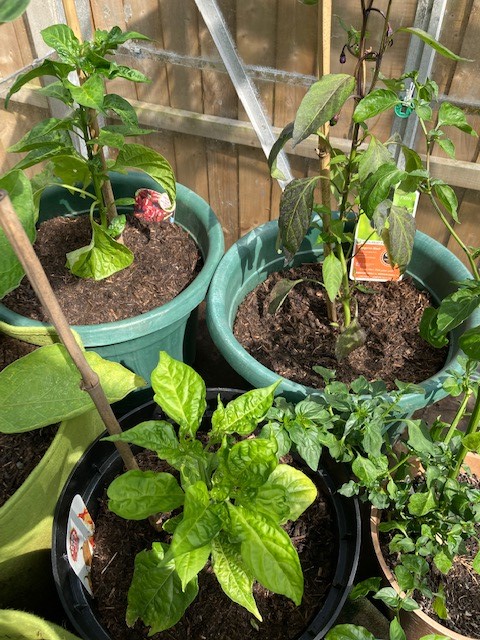
It has certainly been excellent chilli weather in the greenhouse. In fact it has been chilli weather everywhere. The sort of sweaty, day and night heat we have had recently is perfect for chillies, which really hate the temperature fluctuations that come with spring, and hit their stride in a summer heat wave. We have just four plants this year. One of them is ‘Lemon Drop’, a hot, citrussy-flavoured chilli that we overwintered from last year and just started back into growth in spring. We entirely neglected to sow our own seed back in January but happily a visit to the garden centre in April stepped into the breach in surprisingly impressive fashion. Gone are the days when there was just one or two varieties of hot chilli offered by the garden centres; we found a really intriguing and unusual range, and came away with: ‘Habanero Chocolate’, ‘Hungarian Black’, and Trinidad Perfume. We lean towards the milder end of chillies, but if we were chilli fiends we would also have been very well served as there were some really blistering varieties on offer, including super hot ‘Bhut Jolokia’, the ghost pepper, which I don’t even want to stand too near. The heat in chillies is measured in Scoville Units. For reference, a jalapeno pepper, considered to have mild to moderate heat, will be between 2,000-8,000 Scoville units. ‘Bhut Jolokia’ measures around a million. Ouch. I can’t quite imagine why anyone would want to grow that, but each to their own. Having said that my ‘Habanero Chocolate’ is around 500,000, equivalent to a Scotch bonnet pepper, so we will have to be careful with them. ‘Hungarian Black’ will be at jalapeno level at around 7,500. But ‘Trinidad Perfume’ is the one I am most excited to try. I love the fruity flavours of the Caribbean peppers such as Scotch bonnet, but I’m a bit rubbish with that level of heat (the trick, by the way, when cooking with Scotch bonnet, is to drop it into stews whole and try to keep it that way. That way you get all of the flavour with less of the searing heat). So I am really hoping that this pepper brings that flavour without the heat.
All of the peppers are in their final pots now. If you are growing chillies and they are not growing as fast as you would like, try potting them on. Their size is entirely dictated by the size of the pot and if they get root bound they will just stay the size they are. We are also giving them a very dilute feed with every watering now, which is a tip I picked up from Sara Wain formerly of West Dean Gardens and chilli grower extraordinaire. She said that chillies respond much better to a constant drip drip of feed than to a big dose of feed once a week. She also advised against the very common practice of nipping out the central stem on chilli plants. People do this to encourage the plant to grow bushy, but in fact chillies are naturally bushy plants anyway and don’t need it. In addition, that central point will usually bear the very first flower and therefore the very first fruit, and if you nip that out you can set initial fruit production back by several weeks.
The warm weather can’t keep up all summer but with a bit of luck the chillies will get the heat they love as they start to produce fruits and ripen them, and we should have some gorgeous flavours from the greenhouse later this summer.


